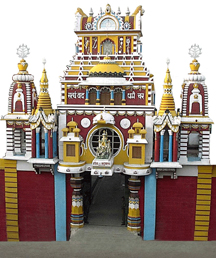 NEW DELHI: Gita Press, which has completed 92 years, has marketed religion successfully like no other publishing house in India and despite claiming to maintain a safe distance from politics, it has regularly taken political stands, says a new book.
NEW DELHI: Gita Press, which has completed 92 years, has marketed religion successfully like no other publishing house in India and despite claiming to maintain a safe distance from politics, it has regularly taken political stands, says a new book.
“Gita Press and the Making of Hindu India” by journalist Akshaya Mukul takes a look at one of the most influential publishing enterprises in the history of modern India and features an extraordinary cast of characters – buccaneering entrepreneurs and hustling editors, nationalist ideologues and religious fanatics.
In the early 1920s, Marwari businessmen turned spiritualists Jaydayal Goyandka and Hanuman Prasad Poddar set up the Gita Press.
As of early 2014, Gita Press had sold close to 72 million copies of the Gita, 70 million copies of Tulsidas’ works and 19 million copies of scriptures like the Puranas and Upanishads.
And while most other journals of the period, whether religious, literary or political, survive only in press archives, Kalyan, a monthly spiritual magazine in Hindi published by the Press, now has a circulation of over two lakh and its English counterpart, Kaylana-Kalpataru, of over one lakh.
The ideas articulated by Gita Press and its publications played a critical role in the formation of a Hindu political consciousness, indeed a Hindu public sphere, says the book.
“As Gita Press stands within striking distance of a century, the only organization that may be said to parallel its success is the Bible Society. No other publishing house in India has marketed religion so successfully. And despite claiming to maintain a safe distance from politics, Gita Press has regularly taken political stands.
“Not only has it played a pivotal role in ‘popular efforts to proclaim Hindu solidarity (sangathan), pious self-identity and normative cultural values’, as a player in the theatre of Hindu nationalism it has also stood side by side with the majoritarian narrative of the RSS, Hindu Mahasabha, Jana Sangh and BJP at every crucial juncture since 1923,” the book, published by HarperCollins India, says.
“And in times of intense communal division, Kalyan has exchanged the sobriety of a religious journal for the language of hate and religious identity. The fact that its publications reach even secular Hindu homes adds to the might and mystique of Gita Press. And as Indian politics becomes more polarized with a definite right turn, organizations like Gita Press may get their second wind,” it says. The author argues that Gita Press created an empire that spoke in a militant Hindu nationalist voice and imagined a quantifiable, reward-based piety and almost every notable leader and prominent voice, including Mahatma Gandhi, was roped in to speak for the cause.
Cow slaughter, Hindi as national language and the rejection of Hindustani, the Hindu Code Bill, the creation of Pakistan, India’s secular Constitution: Kalyan and Kalyana-Kalpataru were the spokespersons of the Hindu position on these and other matters.
Mukul says that “through the power of print, Gita Press sought to influence the policies and politics of free India, supporting various movements, ideologies and organizations that promoted Hindu identity and culture, and opposing those seen as a threat to Sanatan Dharma”.
According to the author, what contributed to Kalyan or Gita Press’ distinguishing presence and immediate success was the fact that its promoters and editor did not remain impervious to the larger political changes taking place in the colonial period.
“The propagation of Sanatan Dharma, with all its emphasis on texts, rituals, social practice and institutions was mixed with the ideals of nationalism,” he says.
The book first looks at the lives of Poddar and Goyandka and places them within the larger paradigm of what the author calls “ascetic nationalist masculinity”.
The thematic chapters that follow describe the founding of Kalyan, its early years and the manner in which Poddar created a web of national and international contributors for the journal and also its English-language counterpart Kalyana-Kalpataru.
Apart from examining the making of Gita Press and the important events in its life, the book looks at how the goals of a religious publishing house in a small Uttar Pradesh town intersected with the aims of right-wing Hindu organizations and nationalism at flashpoints in history from 1926 onwards.
The author says that “at a time when politics has become more divisive, Gita Press’s template is unchanged, and its political agenda remains undiluted, as does its fond hope that India will one day become Hindu”. -PTI






